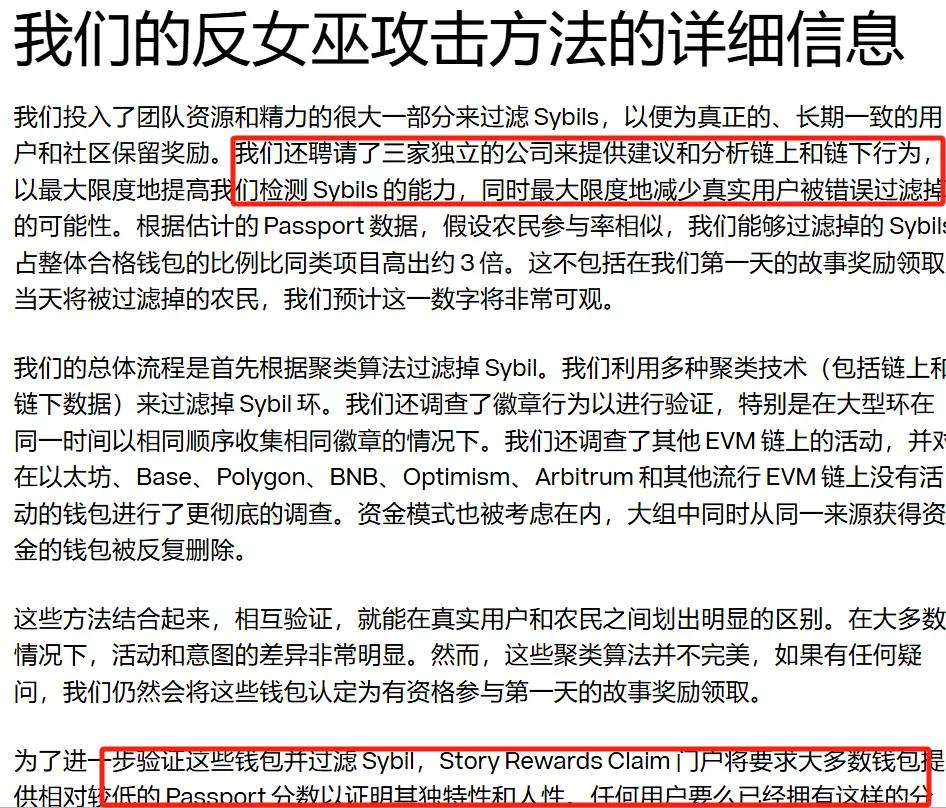Author: Xiyou, ChainCatcher
As a crypto project that has been led and invested in by a16z for three consecutive rounds, with a previous valuation of up to $2.25 billion, the recent performance of Story Protocol has left the community users in shock.
On February 13th, the Story Protocol team finally unveiled the details of the highly anticipated airdrop plan, but contrary to the expected generous rewards, this airdrop plan has sparked a lot of controversy and dissatisfaction. Many studios and investors have expressed that the airdrop conditions are too harsh, with three layers of "witch" screening, and the airdrop token distribution is far lower than expected, already being "reversed".
To make matters worse, on the same day, the Story Protocol token (IP) officially launched its TGE and was immediately listed on exchanges such as CoinBase, Bithumb, and MEXC. The market performance of the token after its listing has also been disappointing, with the price dropping from the $2.3 opening to a low of $1.7, and the secondary market capitalization already showing an inverted phenomenon compared to the financing valuation.
This series of events has undoubtedly dealt a heavy blow to the Story Protocol community users. Many users have expressed that they are at a loss to describe their disappointment with the project team's performance in the airdrop plan and TGE, and have even begun to question the long-term development prospects of the project, with some users publicly seeking redress in the Story Protocol official community.
Harsh Airdrop Conditions: Quantity Far Below Expectations, Multiple "Witch" Barriers, and Requiring a Gitcoin Account Score of 20
The main controversies around the Story Protocol airdrop are: the airdrop amount distributed to users is far lower than expected, the "witch" review conditions are too strict, and the threshold for claiming the airdrop is too high.
Regarding the airdrop token quantity, the expected airdrop token distribution to the community users by Story Protocol is far lower than expected, dropping from the initial 10% to below 5%.
In the IP token economic model announced on February 7th, the total supply is 1 billion, with an initial unlocking of 25%, of which 10% of the tokens will be used for early user incentives.
However, this 10% of tokens is not the full airdrop amount directly distributed to the community, but only 5% is directly allocated to users, and users cannot fully unlock it on the first day of TGE, but need to be gradually released through a series of ongoing initial incentive activities; the other 5% of tokens will be allocated to ecosystem projects and distributed to users through their own incentive activities.
This arrangement has shattered the direct claim fantasies of many investors and left many feeling disappointed. And due to the project team's zero tolerance for "hair-pulling" behavior, a lot of "hair-pulling" will be filtered out, and the unclaimed user incentive portion will be reallocated to the project team, so the actual proportion of tokens distributed directly to the community users is likely to be far less than 5%.
In this airdrop, Story Protocol has shown zero tolerance for "witch" behavior and has adopted an extremely strict screening mechanism to filter out "witches" and "hair-pulling farmers".
According to the information disclosed by the official, Story Protocol has hired three independent companies to provide advice and analysis on on-chain and off-chain behavior to filter out "witches".

Even after successfully passing the "witch" screening, users still need to meet a certain Gitcoin Passport score (20 points) threshold to prove their unique identity and claim the airdrop tokens in a timely manner.
This requirement from Story Protocol has undoubtedly increased the threshold for obtaining the airdrop, and has excluded batch account-brushing studios and farmers. Some community users have expressed resentment, believing that the project team should have clearly stated the Passport score requirement at the beginning of user participation and interaction, rather than suddenly proposing this condition just before the airdrop claim, which has made some users feel "betrayed" by the project team.
In addition, there is also controversy over the airdrop conditions for the Chronicles Genesis NFT issued by Story Protocol last year. Some users have questioned the possibility of unfair insider trading, the so-called "old mouse warehouse". Specifically, the project team not only requires community users to hold Chronicles NFT, but also sets an additional threshold that they must hold Odyssey NFT at the same time in order to qualify for the airdrop. This dual condition has resulted in losses for those users who purchased Chronicles NFT just to obtain the airdrop. It is reported that the purchase price of these NFTs is about 0.1 ETH.
IP Token Secondary Market Underperformance and Inverted Valuation
In addition to the harsh controversies surrounding the airdrop event, the market performance of the IP token has also fallen below the psychological defense line of the community users. After its listing on the secondary market, the IP token has experienced a breakdown, with the token price falling below its original valuation, presenting an inverted phenomenon.
According to OKX market data, since the IP token's debut on the secondary market on February 13th, its price has continued to decline from the $2.25 opening price, at one point dropping to $1.7, and is currently trading at $1.92. The total market capitalization has now adjusted to $1.92 billion, with the secondary market price already lower than its early valuation.
Although the phenomenon of secondary market valuation inversion is not uncommon in the current cryptocurrency field, it is worth noting that Story Protocol is a crypto project that has been led and invested in by a16z three times. Last August, the project successfully completed an $80 million Series B round led by a16z Crypto, with a total cumulative financing of $140 million and a valuation that once reached $2.25 billion.
So why has Story Protocol, which has received so much financing, performed so poorly? User @lejintian666 once pointed out in a tweet that Story Protocol's biggest problem is the lack of performance, as the story behind the project has not yet been realized, lacking actual performance support, so the valuation is naturally difficult to maintain. The founding team, in order to gain benefits, can only try to increase their own chips through strict "witch" screening, which is obviously difficult to gain market recognition.
Faced with the sluggish performance of the IP token in the secondary market, crypto KOL @Chen Jian Jason also expressed his views on social media. He said that all the actions of the Story Protocol protocol have been unexpected. Generally speaking, airdrops and token prices are negatively correlated, but Story did not stabilize the market sentiment through price manipulation after the airdrop controversy. Furthermore, as Story has not been listed on major exchanges and has not paid listing fees, and the airdrop quantity is limited, the market has become almost a "single-machine coin" with scarce chips. However, reviewing those projects that have also received large VC financing but have not been listed on major exchanges, their secondary market performance is often outstanding, and they will prove their strength and value through price manipulation. But Story's current performance has been disappointing, and it seems to have fallen into a state of "lying flat".








